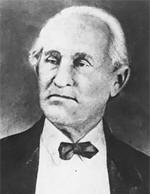Diversion, Battle and A Town Destroyed

Fort Brooke, an important military outpost during the Civil War, sits on the east bank of the Hillsborough River way down south in what we now call Tampa. The fort saw a short conflict in 1863 (October 16-18) that coincided with the Battle of Ballast Point (October 18). The outcomes of both battles left Fort Brooke in Confederate hands and the surrounding waters firmly under the control of the Union but devastated the town and civilians of Tampa.
Tampa businessmen James McKay and David Hope owned and operated a shipping line that ran from Tampa, Florida to Havana, Cuba. McKay is famous for organizing the “Cowboy Cavalry,” a group that supplied beef to the Confederate Army. From the onset of the Civil War, the Union tried to cut off the Confederacy from the rest of the world by means of a naval blockade. But they had struggled to close Tampa and Fort

Brooke, partly due to the daring missions McKay made as a blockade runner. McKay played a significant role in keeping trade routes open and both locations well stocked with needed supplies.
The waters around Tampa Bay were mostly controlled by the Union at the time, but the locals were loyal to the Confederacy. They looked to Fort Brooke as their protector. McKay and his comrades made plans for a blockade run in early October. Two Union sympathizers, Henry Crane and James Thompson, learned about the plan, notified the Union nearby, and devised a plan of their own.
Two Union Warships bombarded Fort Brooke on October 16. But the USS Tahoma and the USS Adela were only a diversion for a landing party. Their mission was to capture several enemy steamers located on the Hillsborough River. Their most important target was McKay’s small fleet. McKay had been captured by the Union in 1861 and pardoned under the condition that he would forever cease serving the Confederacy. When McKay agreed to the terms, he was released and went right back to blockade running. His behavior made him a wanted man.
James Thompson, a native Floridian, led 100 Union foot soldiers up the Hillsborough as soon as the bombardment on Fort Brooke began. The group trudged nearly 14 miles to find McKay’s ships. This is when the plan started to crumble. The Union troops were on the wrong side of the river, across from the shipyard. And they had no means of crossing. The crew of the Scottish Chief, one of McKay’s boats, sent a small boat across the river to see what was amiss. Which the Union took advantage of and used the small vessel to reach McKay’s location. When those aboard the Scottish Chief realized their mistake, it was too late to escape. Only the Captain, McKay, and two crew members managed to flee the Union troops. The rest, along with the boat, were captured.
The Union troops, after making their way aboard McKay’s ship went to destroying it. They would have destroyed the entire ship yard but knowing that a few crew members had escaped they knew that Confederate forces would be on their way. Realizing they would soon be in trouble, the Union headed back the way they came. However, they soon ran into a group of Florida militia. Although the men were badly organized, they had the element of surprise on their side. The militia disguised themselves as Negro women and lured some of the Union men to a small boat were many were killed. The remainder of the Union force headed to Ballast Point, where they were met with more than local militia.
Fort Brooke had be able to send some 40 Confederate troops to make a stand against the Union force. Battle ensued and both sides suffered heavy losses. Curiously enough, the Battle of Ballast Point was claimed as a victory by both sides. Considering the event on a larger scale, it is clear that the small town of Tampa was the real loser in this fight. The town was all but destroyed during the conflict, along with their blockade runners and the local salt works. Tampa was left stranded with no way to get supplies and no way to preserve the supplies they already had.
Six months later, the Union sent three additional boats to Tampa. With this added reinforcement they captured the town along with Fort Brooke. The Union later abandoned Tampa, as it held little military significance to either the North or South.
Florida, as a member of the Confederacy, is often overlooked in history books. The state saw no major battles and therefore little discussion is given about the state’s role in the Civil War. However, the war was very real to Tampa’s citizens. It is not only the large battles that should be remembered, but also the small. Yesterday, October 18, 2013, marked the 150th anniversary of the Battle of Ballast Point. The city of Tampa lied in ruins

and the townsfolk were left to pick up the pieces. As one returning soldier said, the town of “Tampa was hard-looking…and the outlook certainly was not very encouraging.” Though as we can see Tampa had a bright future ahead, and is now a thriving city, completely covering the scars that had been left on the area in 1863.
I have written about Tampa’s role in the Civil War myself, as I lived there for many years and its Civil War history is obscure and often forgotten.
Interesting. I personally have never thought too much about Florida and it’s role in the Civil War battles. As the person above said “obscure and often forgotten” is a good summary for what many think of when it comes to Florida’s involvement. However, it shouldn’t be overlooked as it was very real for those who left home to fight as well as the civilians involved in the state. Thanks for educating and opening our minds to “left out” stories as they are all important in our nation’s history.